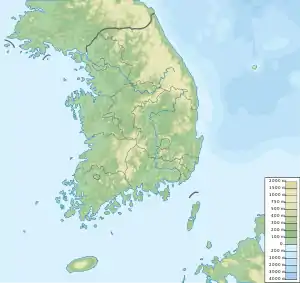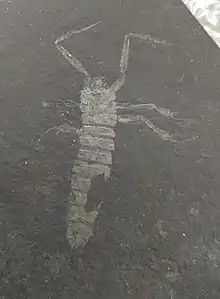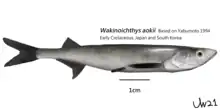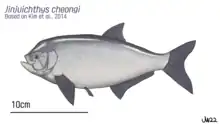| Jinju Formation | |
|---|---|
| Stratigraphic range: Albian ~ | |
| Type | Geological formation |
| Unit of | Shindong Group |
| Underlies | Chilgog Formation, Iljig Formation |
| Overlies | Hasandong Formation |
| Thickness | 1,000–1,800 m (3,300–5,900 ft) |
| Lithology | |
| Primary | Shale |
| Other | Sandstone |
| Location | |
| Coordinates | 35°06′N 128°06′E / 35.1°N 128.1°E |
| Approximate paleocoordinates | 44°18′N 122°42′E / 44.3°N 122.7°E |
| Region | North Gyeongsang Province |
| Country | |
| Extent | Gyeongsang Basin(ko:경상 분지) |
 Jinju Formation (South Korea) | |
The Jinju Formation (Korean: 진주층; Hanja: 晋州層; RR: Jinju-cheung) is an Early Cretaceous geologic formation in South Korea.[1] Dinosaur remains are among the fossils that have been recovered from the formation, although none have yet been referred to a specific genus.[2] The depositional age of this formation spans from approximately 112.4 ± 1.3 to 106.5 million years ago (early Albian) based on detrital zircon U-Pb dating.[3] It predominantly consists of black shale, with sandstone packets, deposited in a fluvial-lacustrine setting.
A diverse spider fauna is known from the formation, including indeterminate mygalomorphs and palpimanoids as well as two species of lagonomegopid belonging to the genera Koreamegops and Jinjumegops.[4] Other compression fossils known from the formation include a species of the zhangsolvid fly Buccinatormyia, the elaterid beetle Koreagrypnus, and the ichthyodectiform fish Jinjuichthys. This formation has also "attracted global ichnological attention" for the variety of important ichnofossils.[5] Columnar and rod-shaped stromatolites have also been found here.[6]
Fossil content
Flora
| Plants of the Jinju Formation | ||||||
|---|---|---|---|---|---|---|
| Genus | Species | Region | Member | Material | Notes | Image |
| Cupressinocladus | C. sp.[7] | The presence of this conifer indicates that mixed-type flora existed in this formation. | ||||
| Ruffordia | R. sp.[8] | Schizaeaceae ferns | ||||
| Cladophlebis | C. sp.[8] | |||||
| Sphenopteris | S. sp.[8] | |||||
| Onychiopsis | O. elongata[9] | leptosporangiate ferns | ||||
| Brachyphyllum | B. japonicum[9] | |||||
Spiders
| Spiders of the Jinju Formation[4] | ||||||
|---|---|---|---|---|---|---|
| Genus | Species | Region | Member | Material | Notes | Image |
| Korearachne | K. jinju | likely to be a lycosoid | ||||
| Koreamegops | K. samsiki | a lagonomegopid | ||||
| Jinjumegops | J. dalingwateri | a lagonomegopid | ||||
| Mygalomorphae | indeterminate | |||||
| Araneomorphae | indeterminate | |||||
| Palpimanoidea | indeterminate | |||||
| "Cribellate Entelegynae" |
|
|||||
Insects
Jinju formation consists of a diverse order of insects: Orthoptera, Homoptera, Mantodea, Diptera, Coleoptera, Hymenoptera, Dermaptera, Neuroptera, Blattoidea, Hemiptera, Odonata, Mecoptera, etc. A larvae fossil of aquatic insect has also been discovered.[6]
Orthoptera
| Orthopterans of the Jinju Formation | ||||||
|---|---|---|---|---|---|---|
| Genus | Species | Region | Member | Material | Notes | Image |
| Panorpidium | P. spica[10] | A member of Elcanidae | ||||
Odonata
| Dragonflies of the Jinju Formation | ||||||
|---|---|---|---|---|---|---|
| Genus | Species | Region | Member | Material | Notes | Image |
| Hemeroscopus | H. baissicus[11] | |||||
Hymenoptera
| Hymenopterans of the Jinju Formation | ||||||
|---|---|---|---|---|---|---|
| Genus | Species | Region | Member | Material | Notes | Image |
| Korehelorus | K. jinjuensis[12] | A parasitic wasp belonging to the family Heloridae | ||||
| Hanguksyntexis | H. haeretica[13] | A sawfly belonging to the family Anaxyelidae | ||||
Raphidioptera
| Snakeflies of the Jinju Formation | ||||||
|---|---|---|---|---|---|---|
| Genus | Species | Region | Member | Material | Notes | Image |
| Mesoraphidia[14] |
|
A member of Mesoraphidiidae | ||||
Blattodea
| Cockroaches of the Jinju Formation[15] | ||||||
|---|---|---|---|---|---|---|
| Genus | Species | Region | Member | Material | Notes | Image |
| Rhipidioblattina |
|
|||||
| Mesoblattina |
|
|||||
| Samaroblatta | S. sp. cf. S. rhypha | |||||
| Blattula |
|
|||||
| Mesoblattula | M. sp. | |||||
| Indeterminate | A total of 13 indeterminate species | |||||
Coleoptera
| Beetles of the Jinju Formation | ||||||
|---|---|---|---|---|---|---|
| Genus | Species | Region | Member | Material | Notes | Image |
| Coptoclava[16] | C. sp | Both nymph and adult fossils found | A member of the extinct family Coptoclavidae. Similar to C. longipoda, but assigned to a yet undescribed species since C. longipoda is usually considered to be a species complex. |  | ||
| Megalithomerus[17] | M. magolhalmii | A member of Elateridae | ||||
| Koreagrypnus[17] | K. jinju | |||||
| Cretosaja[18] | C. jinjuensis | A member of Silphidae | ||||
| Notocupes[19] | N. premeris | A member of Archostemata | ||||
| Asiana[20] | A. pax | |||||
| Brochocoleus[20] | B. sacheonensis | A member of Ommatidae | ||||
| B. cf. punctatus | ||||||
| Omma[20] | O. sp. | |||||
| Zygadenia[20] | Z. cornigera | |||||
Diptera
| Flies of the Jinju Formation | ||||||
|---|---|---|---|---|---|---|
| Genus | Species | Region | Member | Material | Notes | Image |
| Buccinatormyia[21] | B. gangnami | A member of the family Zhangsolvidae. Named after Gangnam Style, the famous K-Pop hit song | ||||
Dermaptera
| Earwigs of the Jinju Formation | ||||||
|---|---|---|---|---|---|---|
| Genus | Species | Region | Member | Material | Notes | Image |
| cf. Pygidicranoidea[22] | indeterminate | |||||
Neuroptera
| Lacewings of the Jinju Formation | ||||||
|---|---|---|---|---|---|---|
| Genus | Species | Region | Member | Material | Notes | Image |
| Tachinymphes[23] | T. koraiensis | A member of the family Mesochrysopidae. | ||||
Termites
| Termites of the Jinju Formation | ||||||
|---|---|---|---|---|---|---|
| Genus | Species | Region | Member | Material | Notes | Image |
| Sclerotermes[24] | S. samsiki | Known only from an isolated wing, uncertain placement | ||||
Crustaceans
Isopoda
| Isopods of the Jinju Formation | ||||||
|---|---|---|---|---|---|---|
| Genus | Species | Region | Member | Material | Notes | Image |
| Archaeoniscus[25] | A. coreaensis | A freshwater occurrence of the genus Archaeoniscus | ||||
Ostracoda
| Ostracods of the Jinju Formation[26] | ||||||
|---|---|---|---|---|---|---|
| Genus | Species | Region | Member | Material | Notes | Image |
| Scabriculocypris | S. cf. yanbianensis | Jeongcheon | ||||
| Cypridea | C. jinjuria in Gwanghyeon | |||||
| Mongolocypris | M. kohi[29] | |||||
| Lycopterocypris | L. cf. celsa | Jeongcheon | ||||
| Candona | C. sp. | |||||
| Djungarica | D. sp. | Jeongcheon | ||||
Spinicaudata
| Clam shrimps of the Jinju Formation | ||||||
|---|---|---|---|---|---|---|
| Genus | Species | Region | Member | Material | Notes | Image |
| Yanjiestheria[30] |
|
|||||
Vertebrates
Actinopterygii
| Fishes of the Jinju Formation[31][32] | ||||||
|---|---|---|---|---|---|---|
| Genus | Species | Region | Member | Material | Notes | Image |
| Wakinoichthys[33] | W. aokii | An osteoglossiform |  | |||
| Jinjuichthys[34] | J. cheongi | An ichthyodectiform |  | |||
| Albuliformes | indeterminate | |||||
| Sinamia | S. sp. | An amiiform | ||||
| Lepidotes | L. sp. | Largest fish found in this formation, reaching 40 cm (1.3 ft) in total length. | ||||
| Lepisosteiformes | indeterminate | |||||
| Elopiformes | indeterminate | A small fish, reaching 3 cm (1.2 in) in total length. | ||||
Archosauria
| Reptiles of the Jinju Formation[31] | ||||||
|---|---|---|---|---|---|---|
| Genus | Species | Region[35] | Member | Material | Notes | Image |
| Crocodyliformes indet. | Goryeong | a right mandible | ||||
| Titanosauriformes indet.[36] | Sacheon | a tooth | Initially suggested to be of Asian Brachiosaurid by Lim, Martin and Baek (2001), but Barrett et al. (2002) and Choi & Lee (2017) considers it to be indeterminate titanosauriform. | |||
| Pterodactyloidea indet. | Goryeong | teeth | While suggested to be of Boreopterid origin by Choi & Lee (2017), Yun (2020) considers them to be Anhanguerian instead.[37] | |||
Mollusks
Bivalvia
| Bivalves of the Jinju Formation[38] | ||||||
|---|---|---|---|---|---|---|
| Genus | Species | Region | Member | Material | Notes | Image |
| Plicatounio | P. naktongensis | |||||
| Nagdongia | N. soni | The genus Nagdongia is considered to be synonymous with Nakamuranaia by some. | ||||
| Trigonioides | T. jaehoi | |||||
Gastropoda
| Gastropods of the Jinju Formation[8] | ||||||
|---|---|---|---|---|---|---|
| Genus | Species | Region | Member | Material | Notes | Image |
| Brontiopsis | B. kobayashi | dominant gastropod of the formation | ||||
| Thiara | T. sp | |||||
| Viviparus[39] | ||||||
Ichnofossils
| Ichnofossils of the Jinju Formation | ||||||
|---|---|---|---|---|---|---|
| Ichnogenus | Ichnospecies | Region | Member | Material | Notes | Image |
| Grallator[40] | Theropod track; similar to the ichnospecies G. yangi | |||||
| Corpulentapus[40] | Theropod track | |||||
| Asianopodus[40] | Theropod track | |||||
| Dromaeosauriformipes[41] | D. rarus | Didactyl tracks made by either juvenile dromaeosaur or very small species of trackmaker, represents the smallest non-avian dinosaur tracks known. | ||||
| Dromaeosauripus[42] | D. jinjuensis | Namhae[35] | Didactyl tracks made by a 40 cm (1.3 ft) tall dromaeosaur. | |||
| Ignotornis | I. seoungjoseoi[43] | Bird Track | ||||
| Jindongornipes | J. isp.[43] | Bird Track | ||||
| Koreasaltipes[44] | K. jinjuensis | Jinju[35] | Traces left by a hopping mammal | |||
| Neosauroides | N. innovatus[45] | The largest reported lizard trackway in South Korea. | ||||
| cf. Chelichnus[46] | Sacheon[35] | Turtle trackway. | ||||
| Ranipes[46] | indeterminate | Oldest known frog trackway. Made by a species that hopped in short distances. | ||||
| Crocodylopodus[47] | First report of this ichogenus from Asia. | |||||
| Batrachopus | B. grandis[48] | Track made by a 3 m (9.8 ft) long bipedal crocodylomorph; the pterosaur trackway ichnospecies Haenamichnus gainensis from the Haman Formation is now assigned to this species as B. cf. grandis.[48] Paleontologist James I. Kirkland expresses doubts on the ichnogenus assignment.[49] | ||||
| Minisauripus | M. isp.[5] | One of the smallest known theropod tracks. Currently the oldest record of this ichnogenus from South Korea. | ||||
| Pteraichnus | Pterosaur trackway. P. seopoensis is currently a naked name, since it was only described in a master's thesis. | |||||
| Lockeia | L. gigantus[39] | Resting bivalve trace fossils | ||||
| Diplichnites | D. isp.[8] | Arthropod tracks | ||||
| Coclichnus | C. isp.[8] | Trace by Annelida tracemakers | ||||
| Radialimbricatus[52] | R. bitoensis | Potential tracemakers include arthropods, cnidarians or annelids | ||||
| Protovirgularia[53] | P. dichotoma | First nonmarine occurrence of this ichnotaxon; possibly made by larvae of dragonfly[54] | ||||
| Fictovichnus[55] | indeterminate | Probable insect cocoon or pupation chamber; the earliest record of an insect pupation structure probably associated with a burrow | ||||
See also
References
- ↑ Jinju Formation in the Paleobiology Database
- ↑ Weishampel, David B.; Barrett, Paul M.; Coria, Rodolfo A.; Le Loueff, Jean; Xu, Xing; Zhao, Xijin; Sahni, Ashok; Gomani, Emily M.P.; Noto, Christopher N. (2004). "Dinosaur distribution". In Weishampel, David B.; Dodson, Peter; Osmólska, Halszka (eds.). The Dinosauria (Second ed.). Berkeley: University of California Press. pp. 517–607. ISBN 978-0-520-24209-8.
- ↑ Chae, Yong-Un; Lim, Jong Deock; Kim, Cheong-Bin; Kim, Kyung Soo; Ha, Sujin; Lim, Hyoun Soo (2020). "Detrital zircon U-Pb ages of the uppermost Jinju Formation in the Natural Monument No. 534 'Tracksite of Pterosaurs, Birds, and Dinosaurs in Hotandong, Jinju', Korea" (PDF). Journal of the Korean Earth Science Society. 41 (4): 367−380. doi:10.5467/JKESS.2020.41.4.367. S2CID 225332234.
- 1 2 Park, Tae-Yoon S.; Nam, Kye-Soo; Selden, Paul A. (2019-08-03). "A diverse new spider (Araneae) fauna from the Jinju Formation, Cretaceous (Albian) of Korea". Journal of Systematic Palaeontology. 17 (15): 1271–1297. doi:10.1080/14772019.2018.1525441. ISSN 1477-2019. S2CID 92137182.
- 1 2 Kim, Kyung Soo; Lockley, Martin G.; Lim, Jong Deock; Xing, Lida (2019). "Exquisitely-preserved, high-definition skin traces in diminutive theropod tracks from the Cretaceous of Korea". Scientific Reports. 9 (1): 2039. Bibcode:2019NatSR...9.2039K. doi:10.1038/s41598-019-38633-4. PMC 6375998. PMID 30765802.
- 1 2 Paik, I.S. (2005). "The oldest record of microbial-caddisfly bioherms from the Early Cretaceous Jinju Formation, Korea: occurrence and palaeoenvironmental implications" (PDF). Palaeogeography, Palaeoclimatology, Palaeoecology. 218 (3−4): 301−315. Bibcode:2005PPP...218..301P. doi:10.1016/j.palaeo.2004.12.020.
- ↑ Kim, Jong-Heon (2009). "New occurrence of Cupressinocladus sp. from the Lower Cretaceous Jinju Formation, Shindong Group, Korea" (PDF). Journal of the Korean Earth Society. 30 (5): 605−610. Bibcode:2012JPal...86..626P. doi:10.1666/11-131R.1. S2CID 131617665.
- 1 2 3 4 5 6 Paik, In Sung; Kim, Hyun Joo; Kim, Seongyeong; Lee, Jeong Eun; So, Yoon Hwan; Lee, Hoil (2019-10-31). "Fossil-bearing deposits in the Jinju Formation at Jinju: Occurrences, paleoenvironments and stratigraphic implications" (PDF). Journal of the Geological Society of Korea. 55 (5): 513–530. doi:10.14770/jgsk.2019.55.5.513. ISSN 0435-4036. S2CID 210608913.
- 1 2 Kim, Jong-Heon; Nam, Kye-Soo; Lee, Seong-Bok; Jeon, Yeong-Seok (2016). "Fossil Plants from the Early Cretaceous Hasandong Formation of Chilgok Area, Korea" (PDF). Journal of the Korean Earth Science Society. 37 (5): 295−308. doi:10.5467/JKESS.2016.37.5.295.
- ↑ Kim, Do-Yoon; Lee, Mirinae; Nam, Gi-Soo; Park, Tae-Yoon S. (2021). "The first orthopteran fossils from the Lower Cretaceous (Albian) Jinju Formation of Korea: Ethological implications for elcanids". Cretaceous Research. 125: 104843. Bibcode:2021CrRes.12504843K. doi:10.1016/j.cretres.2021.104843.
- ↑ Nam, Kye-Soo; Kim, Jong-Heon (2016). "Reconstruction and Paleoecological implications of Dragonfly Hemeroscopus baissicus Pritykina 1977 (Hemeroscopidae) from the Lower Cretaceous Jinju Formation in the Jinju area, Korea". Journal of the Geological Society of Korea. 52 (2): 102–112. doi:10.14770/jgsk.2016.52.2.105.
- ↑ Rosse-Guillevic, Simon; Rasnitsyn, Alexandr P.; Nam, Gi-Soo; Jouault, Corentin (April 2023). "The first Heloridae (Hymenoptera: Proctotrupoidea) from the Albian of the Republic of Korea: inferences about the relict diversity of the family". Cretaceous Research. 151: 105564. Bibcode:2023CrRes.15105564R. doi:10.1016/j.cretres.2023.105564. S2CID 258269517.
- ↑ Rosse-Guillevic, Simon; Kopylov, Dmitry S.; Rasnitsyn, Alexander P.; Nam, Gi-Soo; Kwon, Seung-Hyuk; Jouault, Corentin (August 2023). "Blurring the limits of anaxyelid subfamilies: a new genus and species (Hymenoptera: Anaxyelidae) from the Albian of the Republic of Korea". Palaeoentomology. 6 (4): 424–434. doi:10.11646/palaeoentomology.6.4.13. S2CID 261307640.
- ↑ Engel, Michael S; Lim J.-D.; Baek, K.-S. (2006-04-25). "Fossil snakeflies from the Early Cretaceous of southern Korea (Raphidioptera: Mesoraphidiidae)". Neues Jahrbuch für Geologie und Paläontologie - Monatshefte. 2006 (4): 249–256. doi:10.1127/njgpm/2006/2006/249. ISSN 0028-3630.
- ↑ Baek, Kwang-Seok; Yang, Seung-Yeong (2004). "Cockroaches from the early Cretaceous of Korea (Blattaria: Mesoblattinidae)". Journal of the Paleontological Society of Korea (in Korean). 20: 71–98 – via DBpia.
- ↑ Nam, K.S.; Park, T.Y.; Kim, Y.H. (2013-12-31). "Preliminary research on the aquatic coleopteran, Coptoclava from the Early Cretaceous Jinju Formation". Journal of the Geological Society of Korea. 49 (6): 617–624. doi:10.14770/jgsk.2013.49.6.617.
- 1 2 Sohn, Jae-Cheon; Nam, Gi Soo; Choi, Sei-Woong; Ren, Dong (2019-12-11). Robillard, Tony (ed.). "New fossils of Elateridae (Insecta, Coleoptera) from Early Cretaceous Jinju Formation (South Korea) with their implications to evolutionary diversity of extinct Protagrypninae". PLOS ONE. 14 (12): e0225502. Bibcode:2019PLoSO..1425502S. doi:10.1371/journal.pone.0225502. ISSN 1932-6203. PMC 6905514. PMID 31826006.
- ↑ Sohn, Jae-Cheon; Nam, Gi Soo (2021). "New fossil genus and species of carrion beetle (Coleoptera, Silphidae) from the Lower Cretaceous Jinju Formation, South Korea". Journal of Asia-Pacific Entomology. 24 (3): 584–587. doi:10.1016/j.aspen.2021.05.003. S2CID 236585083.
- ↑ Lee, Soo Bin; Nam, Gi Soo; Li, Yan-Da (2022). "A new species of Notocupes (Coleoptera: Archostemata) from the Lower Cretaceous (Albian) Jinju Formation in South Korea". Cretaceous Research. 140: 105357. Bibcode:2022CrRes.14005357L. doi:10.1016/j.cretres.2022.105357. S2CID 252147645.
- 1 2 3 4 Lee, S.B.; Nam, G.S.; Park, J.K.; Lee, B.H.; Li, Y.-D. (2023). "Cretaceous beetles of the Jinju Formation (Coleoptera): Archostemata". Palaeoentomology. 6 (5): 496–506. doi:10.11646/PALAEOENTOMOLOGY.6.5.8. S2CID 264597717.
- ↑ Khramov, Alexander V.; Nam, Gi-Soo; Vasilenko, Dmitry V. (2020-01-02). "First long-proboscid flies (Diptera: Zhangsolvidae) from the Lower Cretaceous of South Korea". Alcheringa: An Australasian Journal of Palaeontology. 44 (1): 160–168. Bibcode:2020Alch...44..160K. doi:10.1080/03115518.2019.1664634. ISSN 0311-5518. S2CID 213651448.
- ↑ Engel, Michael A.; Lim, Jong-Deock; Baek, Kwang-Seok; Martin, Larry D. (2002). "An Earwig from the Lower Cretaceous of Korea (Dermaptera: Forficulina)". Journal of the Kansas Entomological Society. 75 (2): 86–90. JSTOR 25086049.
- ↑ Khramov, A.V.; Nam, G.S. (2020). "The First Record of Lacewings (Insecta: Neuroptera: Mesochrysopidae) from the Lower Cretaceous of South Korea". Paleontological Journal. 54 (6): 613–616. doi:10.1134/S003103012005007X. S2CID 227133826.
- ↑ Jouault, Corentin; Nam, Gi-Soo (2022-07-07). "A new primitive termite from the lower cretaceous (Albian) Jinju Formation of Korea". Historical Biology. 35 (9): 1522–1527. doi:10.1080/08912963.2022.2098490. ISSN 0891-2963. S2CID 250373231.
- ↑ Park, Tae-Yoon; Wilson, George D. F.; Lee, Dong-Chan; Choi, Duck K. (2012). "Occurrence of the Isopod Archaeoniscus coreaensis New Species from the Lower Cretaceous Jinju Formation, Korea". Journal of Paleontology. 86 (4): 626–640. Bibcode:2012JPal...86..626P. doi:10.1666/11-131R.1. JSTOR 23253719. S2CID 131617665.
- ↑ Choi, Byung-Do. (2019). Cretaceous non-marine ostracods from Korea. (Doctoral dissertation).
- ↑ Choi, Byung-Do; Jia, Baoyan; Huh, Min; Jung, Jongyun; Wang, Yaqiong (2021-11-01). "Taxonomy, biostratigraphic and paleoecological aspects of non-marine ostracod fauna from the Jinju Formation (Albian) of the Gyeongsang Basin, South Korea". Cretaceous Research. 127: 104944. Bibcode:2021CrRes.12704944C. doi:10.1016/j.cretres.2021.104944. ISSN 0195-6671.
- ↑ Choi, Byung-Do; Wang, Ya-Qiong; Huh, Min (2018-09-01). "Cypridea species (Crustacea, Ostracoda) from the Lower Cretaceous Jinju Formation of the Gyeongsang Basin, South Korea". Palaeoworld. 27 (3): 382–391. doi:10.1016/j.palwor.2018.03.005. ISSN 1871-174X. S2CID 135191249.
- ↑ Choi, Byung-Do; Huh, Min (2016-01-01). "Mongolocypris kohi sp. nov.: A new Early Cretaceous non-marine ostracod species from the Jinju Formation, South Korea". Cretaceous Research. 57: 239–247. Bibcode:2016CrRes..57..239C. doi:10.1016/j.cretres.2015.09.008. ISSN 0195-6671.
- ↑ Park, Sun-Ok; Chang, Ki-Hong (1998). "Some Cretaceous conchostracans of Kyongsang basin". Journal of the Paleontological Society of Korea. 14 (2): 179–199.
- 1 2 Choi, Seung; Lee, Yuong-Nam (2017). "A review of vertebrate body fossils from the Korean Peninsula and perspectives". Geosciences Journal. 21 (6): 867–889. Bibcode:2017GescJ..21..867C. doi:10.1007/s12303-017-0040-6. ISSN 1226-4806. S2CID 133835817.
- ↑ Yabumoto, Y.; Yang, S.Y.; Kim, T.W. (2006). "Early Cretaceous freshwater fishes from Japan and Korea" (PDF). Journal of the Paleontological Society of Korea. 22 (1): 119–132. S2CID 53309909.
- ↑ Yabumoto, Yoshitaka; Yang, Seong-Young (2000). "The first record of the Early Cretaceous freshwater fish, Wakinoichthys aokii, from Korea". Bulletin of the Kitakyushu Museum of Natural History. 19: 105–110.
- ↑ Kim, Haang-Mook; Chang, Mee-Mann; Wu, Feixiang; Kim, Yang-Hee (2014). "A new ichthyodectiform (Pisces, Teleostei) from the Lower Cretaceous of South Korea and its paleobiogeographic implication". Cretaceous Research. 47: 117–130. Bibcode:2014CrRes..47..117K. doi:10.1016/j.cretres.2013.11.007.
- 1 2 3 4 Kim, Jeong Yul; Huh, Min (2018). Dinosaurs, Birds, and Pterosaurs of Korea: A Paradise of Mesozoic Vertebrates (PDF). Springer Nature. ISBN 978-981-10-6998-7.
- ↑ Lim, J.-D.; Martin, L.D.; Baek, K.-S. (2001-02-01). "The first discovery of a brachiosaurid from the Asian continent". Naturwissenschaften. 88 (2): 82–84. Bibcode:2001NW.....88...82L. doi:10.1007/s001140000201. ISSN 1432-1904. PMID 11320893. S2CID 39381123.
- ↑ Yun, Chan-Gyu (2020). "Boreopterid pterosaur fossils from South Korea reconsidered". New Mexico Museum of Natural History and Science Bulletin. 82: 567–568.
- ↑ Yun, Cheol-Soo; Yang, Seung-Yeong (2004). "Three bivalve fossils from the Dongmyeong Formation of Gisan, Goryeong in Korea". Journal of the Paleontological Society of Korea. 20 (2): 173–181 – via DBpia.
- 1 2 Kim, Kyung Soo; Kim, Jeong Yul (2008). "Lockeia gigantus ichnosp. nov. in the Lacustrine Deposits of the Early Cretaceous Jinju Formation, Southern Coast of Korea" (PDF). Journal of the Korean Earth Society. 29 (1): 13–28. doi:10.5467/JKESS.2008.29.1.013. ISSN 1225-6692.
- 1 2 3 Kim, Kyung Soo; Lim, Jong Deock; Lockley, Martin G.; Xing, Lida; Ha, Su Jin; Kim, Cheong Bin; Paik, In Sung; Ahn, Jae Hong; Mun, Seok Chan (2018). "First reports of a distinctive theropod track assemblage from the Jinju Formation (Lower Cretaceous) of Korea provides strong correlations with China". Cretaceous Research. 81: 26–35. Bibcode:2018CrRes..81...26K. doi:10.1016/j.cretres.2017.08.005.
- ↑ Kim, Kyung Soo; Lim, Jong Deock; Lockley, Martin G.; Xing, Lida; Kim, Dong Hee; Piñuela, Laura; Romilio, Anthony; Yoo, Jae Sang; Kim, Jin Ho; Ahn, Jaehong (2018-11-15). "Smallest known raptor tracks suggest microraptorine activity in lakeshore setting". Scientific Reports. 8 (1): 16908. Bibcode:2018NatSR...816908K. doi:10.1038/s41598-018-35289-4. ISSN 2045-2322. PMC 6237872. PMID 30442900.
- ↑ Kim, Jeong Yul; Lockley, Martin G.; Woo, Jeong Ok; Kim, Sam Hyang (2012). "Unusual didactyl traces from the Jinju Formation (Early Cretaceous, South Korea) indicate a new ichnospecies of Dromaeosauripus". Ichnos: An International Journal for Plant and Animal Traces. 19 (1–2): 75–83. Bibcode:2012Ichno..19...75K. doi:10.1080/10420940.2012.664054. S2CID 129875076.
- 1 2 Kang, Seung Hyeop; Buckley, Lisa G.; McCrea, Richard T.; Kim, Kyung-Soo; Lockley, Martin G.; Lim, Jong Deock; Lim, Hyun Soo; Kim, Cheong-Bin (2021). "First report of bird tracks (Ignotornis seoungjoseoi ichnosp. nov.) from the Jinju Formation (Lower Cretaceous), Sacheon City, Korea". Cretaceous Research. 127 (11): 104899. Bibcode:2021CrRes.12704899K. doi:10.1016/j.cretres.2021.104899.
- ↑ Kim, Kyung Soo; Lim, Jong Deock; Lockley, Martin G.; Xing, Lida; Choi, Yeongi (2017). "Korean trackway of a hopping, mammaliform trackmaker is first from the Cretaceous of Asia". Cretaceous Research. 74: 188–191. Bibcode:2017CrRes..74..188K. doi:10.1016/j.cretres.2017.02.005.
- ↑ Kim, Kyung Soo; Lim, Jong Deock; Lockley, Martin G.; Kim, Dong Hee; Pinuela, Laura; Yoo, Jae Sang (2019). "Largest Cretaceous lizard track assemblage, new morphotypes and longest trackways comprise diverse components of an exceptional Korean Konservat-Lagerstätten ichnofauna". Scientific Reports. 9 (1): 13278. Bibcode:2019NatSR...913278K. doi:10.1038/s41598-019-49442-0. PMC 6746761. PMID 31527673.
- 1 2 Kim, Kyung Soo; Lockley, Martin G.; Lim, Jong Deock; Kim, Dong Hee (2019). "The oldest known anuran (frog) trackways from the Jinju Formation, Lower Cretaceous, Korea". Cretaceous Research. 96: 142–148. Bibcode:2019CrRes..96..142K. doi:10.1016/j.cretres.2018.12.008. S2CID 134521999.
- ↑ Lockley, Martin G.; Lim, Jong Deock; Park, Hong Deock; Romilio, Anthony; Yoo, Jae Sang; Choi, Ji Won; Kim, Kyung Soo; Choi, Yeongi; Kang, Seung-Hyeop; Kim, Dong Hee; Kim, Tae Hyeong (2020-07-01). "First reports of Crocodylopodus from East Asia: implications for the paleoecology of the Lower Cretaceous". Cretaceous Research. 111: 104441. Bibcode:2020CrRes.11104441L. doi:10.1016/j.cretres.2020.104441. ISSN 0195-6671. S2CID 216164973.
- 1 2 Kim, Kyung Soo; Lockley, Martin G.; Lim, Jong Deock; Bae, Seul Mi; Romilio, Anthony (2020-06-11). "Trackway evidence for large bipedal crocodylomorphs from the Cretaceous of Korea". Scientific Reports. 10 (1): 8680. Bibcode:2020NatSR..10.8680K. doi:10.1038/s41598-020-66008-7. ISSN 2045-2322. PMC 7289791. PMID 32528068.
- ↑ Kirkland, James I. [@Paleojim] (June 23, 2022). "I am shocked at the degree of lumping needed to assign this ichnotaxon to Batrachopus... Over splitting is certainly a problem with tracks, but this goes a bit too far in the other direction. Otherwise a very interesting and important paper. Bipedal crocs" (Tweet) – via Twitter.
- ↑ Ha, Sujin; Kim, Kyung Soo; Lim, Hyoun Soo; Lockley, Martin G.; Yoo, Jae Sang; Lim, Jong Deock (2022-03-01). "Diminutive pterosaur tracks and trackways (Pteraichnus gracilis ichnosp. nov.) from the Lower Cretaceous Jinju Formation, Gyeongsang Basin, Korea". Cretaceous Research. 131: 105080. Bibcode:2022CrRes.13105080H. doi:10.1016/j.cretres.2021.105080. ISSN 0195-6671. S2CID 240322960.
- ↑ Ha, Sujin; Chae, Yong-Un; Lim, Jong Deock; Kim, Cheong-Bin; Lim, Hyoun Soo; Kim, Kyung Soo (2018-10-30). "Cretaceous Pterosaur Tracks in Daegok-ri, Ulju-gun, Ulsan: Spatio-temporal Distribution of Pterosaur in the Korean Peninsula". Journal of the Korean Earth Science Society. 39 (5): 458–472. doi:10.5467/JKESS.2018.39.5.458. ISSN 1225-6692. S2CID 133982306.
- ↑ Lee, Dong-Chan (2017). "Radialimbricatus, a new ichnogenus from the lacustrine sandstone facies of the Lower Cretaceous Jinju Formation, South Korea". Alcheringa: An Australasian Journal of Palaeontology. 41 (3): 350–364. Bibcode:2017Alch...41..350L. doi:10.1080/03115518.2017.1283053. S2CID 132462007.
- ↑ Kim, J.Y.; Kim, K.S.; Pickerill, R.P. (2000). "Trace Fossil Protovirgularia McCoy, 1850 from the Nonmarine Cretaceous Jinju formation of the Sacheon area, Korea" (PDF). Journal of the Korean Earth Science Society. 21 (6): 695–702. S2CID 127766832.
- ↑ Metz, R. (2003). "Nonmarine Cretaceous Protovirgularia: Possible Dragonfly Larva Tracemaker". Ichnos. 9 (1–2): 75–76. Bibcode:2003Ichno...9...75M. doi:10.1080/10420940190034094. S2CID 128815122.
- ↑ Lee, Dong-Chan (2018). "Probable insect cocoon or pupation chamber in a channel-fill sandstone bed of the Lower Cretaceous Jinju Formation, South Korea". Lethaia. 51 (3): 433–443. doi:10.1111/let.12257.
Bibliography
- Lee, Tae-Ho; Park, Kye-Hun; Yi, Keewook (2018). "Nature and evolution of the Cretaceous basins in the eastern margin of Eurasia: A case study of the Gyeongsang Basin, SE Korea". Journal of Asian Earth Sciences. 166: 19–31. Bibcode:2018JAESc.166...19L. doi:10.1016/j.jseaes.2018.07.004. S2CID 135061525.
- Weishampel, David B.; Dodson, Peter; Osmólska, Halszka, eds. (2004). The Dinosauria (2nd ed.). Berkeley: University of California Press. ISBN 0-520-24209-2. Retrieved 2019-02-21.